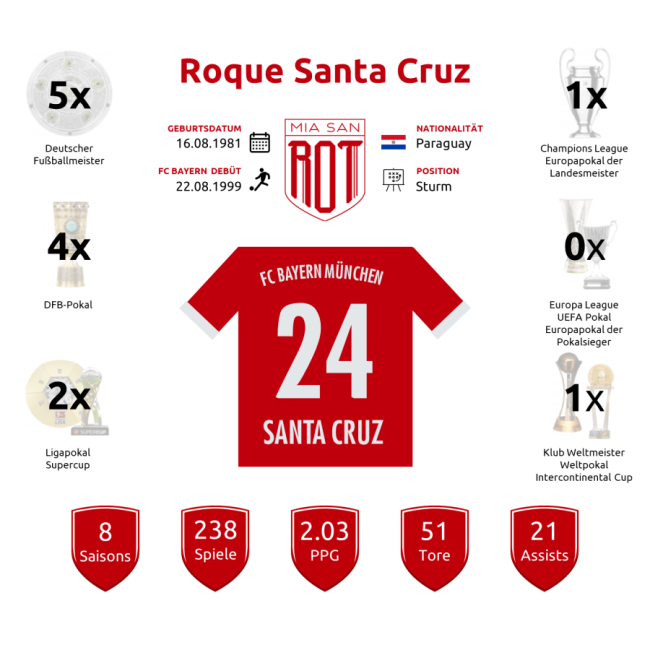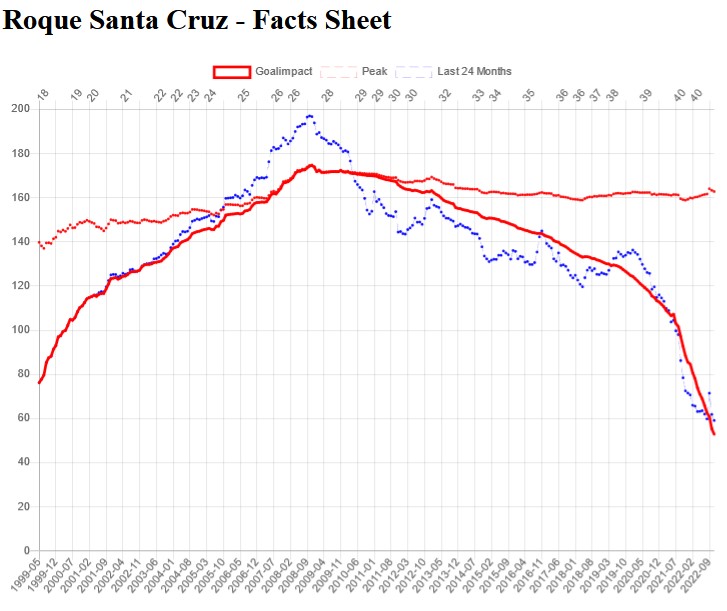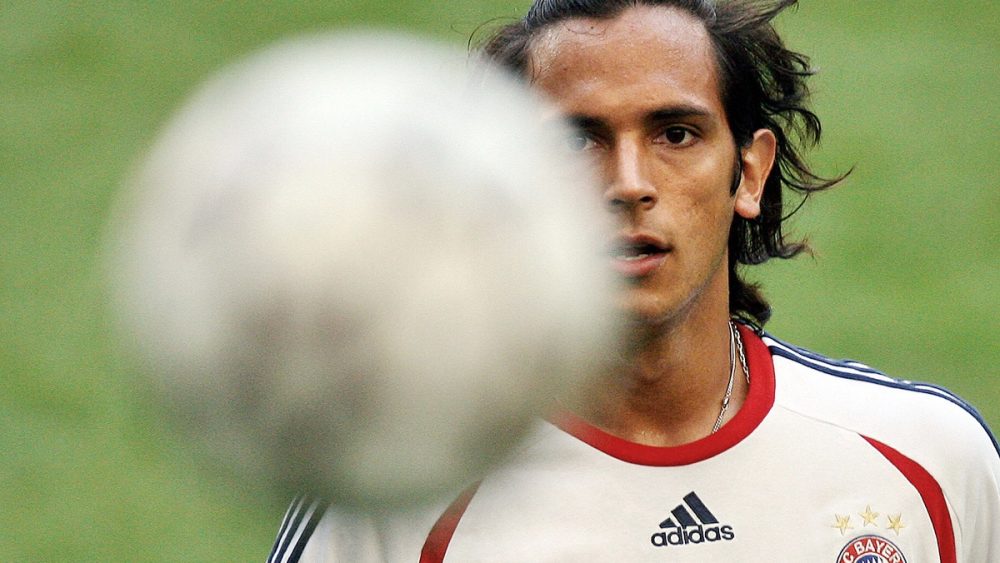FC Bayern – Miasanrot Advent Calendar, Door 24: Roque Santa Cruz
The YouTube algorithm is sometimes a wonderful thing. All you have to do is watch “Oliver Kahn best saves” videos often enough and eventually your personal YouTube feed will consist almost exclusively of videos and snippets that have some connection to FC Bayern or goalkeepers. Delightful.
Recently, I was recommended a video entitled “Roque Santa Cruz pone el 3-1 vs Olimpia”. In it, a tall Roque Santa Cruz in his early 30s, wearing a black and white shirt, heads home the 3-1 for Libertad from Asunción against Olimpia from Asunción. Only after a second and third look did I understand: the video is from this year and Santa Cruz only looks like he is in his early 30s. In real life, though, the former Bayern striker is meanwhile in his early 40s and clearly still plays an essential role at the Primera Division’s top club. What a career.

It has been 23 years and at least three football generations since one Roque Santa Cruz joined FC Bayern as a smiling but also rather shy newcomer at the age of 17. Santa Cruz, who by that time had already made his debut in Paraguay’s first league at the age of 16, had caught the eye of the Bayern scouts at the Junior World Cup in spring 1999. Paraguay were eliminated by Uruguay on penalties in the last 16, but had previously topped the group alongside Germany. The tournament produced a number of future world stars, including Ronaldinho, Xavi and Diego Forlan.
THE NEXT RONALDO? NOT SO MUCH
The transfer was quite a sensation. Teenage transfers – and from South America at that – were still an absolute rarity, especially for FC Bayern. Santa Cruz was the most expensive transfer in Paraguay’s history, costing around €5 million. The German media quickly started talking about the “new Ronaldo” (Kicker) who had descended on Munich. Hoeneß said that Santa Cruz would be “probably our best player in the world in five years’ time”. With such baggage put on Santa Cruz’s shoulders, his career at Bayern was already finished before it had even started.
How can a player fulfil such expectations? Santa Cruz struggled for a total of eight years. Eight years in which the “what if…” hovered over each of his games. It was always about what would be possible if he finally… yes what actually… took the next step? Finally playing with freedom? Finally becoming more consistent? Finally finding his position? Finally staying injury-free for longer? Finally going all in? To be fair, Santa Cruz also fed this narrative himself with his few interviews he gave. The idea of Santa Cruz was surrounded by so much subjunctive that it completely obscured the appreciation of Santa Cruz as a footballer in the here and now.
Perhaps it would have been possible, then, to recognize that a teenage Santa Cruz was able to collect a lot of playing time in his first year and scored nine times in all competitions. Perhaps the focus could have been more on improving his weaknesses (too inconsistent in his active participation in Bayern’s game, sometimes too playful in the penalty area, core strength) and strengthening his strengths (heading, ball handling, positioning in the penalty area) and thus a very good Bayern player could have emerged. But that’s subjunctive, too.
Santa Cruz often played alongside Giovane Elber or later Claudio Pizarro. He often had to shift to a wing position for them. That didn’t really suit his game, because although he had outstanding ball control, even at a young age he wasn’t exactly a capable dribbler at speed due to his high centre of gravity. His good heading game stood out. Perhaps his most important goal in a Bayern shirt was the header against Bayer Leverkusen on matchday 32 of the 2000/2001 season, a goal that laid the groundwork for the subsequent last-minute championship at HSV. Santa Cruz consistently scored five Bundesliga goals per season between 1999 and 2004, despite numerous injuries. On reflection, that’s not the end of the world, but rather quite alright for an U23 player.
EXPLOSION AT BLACKBURN
After a number of more turbulent years, some of them with serious knee injuries, the team later tried Santa Cruz in the number 10 position under Magath. In 2006, this worked so well that Karl-Heinz Rummenigge chose him as Michael Ballack’s successor. That didn’t work out at all. After a generally poor 2006/2007 season, Santa Cruz left for England at the age of 25, unnerved. The transfer fee was again around €5 million – as it had been in 1999 for his move to Bayern. That fits. Eight years in which an unbelievable amount happened, Santa Cruz won all the important titles, scored over 30 Bundesliga goals, took part in two World Cups and yet somehow found himself back at square one.
Of course, what was bound to happen finally happened the following year. Santa Cruz exploded at Blackburn Rovers. He scored 19 Premier League goals, the fourth most behind Cristiano Ronaldo, Emmanuel Adebayor and Fernando Torres. This marks the start of the second phase of Roque Santa Cruz’s career, which later would take him via Manchester City, Malaga and Betis Sevilla back to Paraguay in 2016 where – as I was recently privileged to learn thanks to the mysterious ways of the YouTube algorithm – he is still scoring goals. However, he never played as well again as he did for Blackburn in 2007/2008.
I’ve often wondered what was different about this year compared to the many Bayern years before it, when his breakthrough failed to materialize. Of course, there is the weight of expectations that fell away. Santa Cruz also spoke at the time of feeling really needed for the first time in years.

Sporting-wise, however, there were two things that stood out on closer inspection: Santa Cruz played as a true centre-forward for Blackburn, unlike at Bayern. Not as a winger in disguise or as a withdrawn center-forward, but close to the goal. In addition, from his mid-20s onwards he seemed more physically defined, more stable. Despite his 1.93 metres he no longer seemed gangly and liable to be thrown off balance by a slight push on the back. When elegance with the ball, resilience to tackling and confident heading came together – and they did more often during his Blackburn days – that was peak Santa Cruz.
Looking back over 800 competitive games and over 200 competitive goals today, one can only take one’s hat off to Roque Santa Cruz’s career. And the greater the distance, the more at peace with his time at Bayern one can be in retrospect. He did not become a second Ronaldo. But then again, hardly anyone ever did, to be honest.
So only a slightly sour aftertaste remains that the best Santa Cruz at the peak of his powers did not wear a red shirt, but a blue and white one. So what would have been if Santa Cruz had simply joined FC Bayern a little later….. but for once let’s not indulge the subjunctive.




 December 26, 2022
December 26, 2022 


